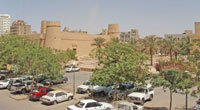
VISITORS to Riyadh with a little time on their hands may be surprised to find how many attractions there are in the capital.
With the exception of dining out, Riyadh is not normally regarded as a city of entertainment. Cinemas, concerts and theatre are banned and its residents view going to the latest shopping mall as one of the mainstays of their leisure pursuits. (It was recently estimated that Riyadh shoppers spend in the order of $13 billion annually in the city’s malls and souqs.)
Visitor attractions centre around the kingdom’s history with the King Abdul Aziz Historical Centre and National Museum playing a central role in must see tourist sights. There are well over 20 museums in Riyadh alone since the Saudis love museums; and along with their passion for all things educational, anything that can possibly be shown off in the comforts of an air-conditioned building will sooner or later end up on display in a glass case.
Riyadh’s museums are many and varied but as often as not, you may find them tightly locked up just waiting for a visitor to come along and ask to be let in. Perseverance usually pays dividends as the guardians are usually only too pleased to show off their amazing collections. The first time visitor would do well to put the National Museum on the top of his agenda. Located in the old town close to the Murabba Palace, it features eight galleries telling the story of the country and its religion from earliest times to the present day.
There are also museums devoted to such diverse subjects as the life and times of King Faisal, ancient Islamic artefacts, philately and numismatics, the country’s wildlife, anatomy, pharmaceuticals and the Royal Saudi Airforce. Opening times vary depending on whether you are male or female, along with the day of the week; but one of the best listings can be found on www.riyadh-ksa.com.
Here too you will find details of some of the city’s historical sites, such as the Masmak Fort which was captured by the young Abdul Aziz in 1902 and which is generally regarded as the start of the unification process of Saudi Arabia. Although playing such a central role in the history of the country, it is not well signposted but again, with perseverance is well worth a visit.
About 30kms north of central Riyadh are the ruins of Dir’iyyah, the historic seat of the Al Saud family and one of the country’s most popular archaeological sites. Founded in 1446, but razed by the Turks in 1818, it is being extensively but sympathetically restored and is a paradise for photographers and artists.
History and culture apart, there are many other activities to tempt the casual visitor. Souqs dedicated to antiques, incense, camels, pets, gold, cars, fish – in fact anything where like minded traders have got together – are guaranteed to attract the least shopaholic of visitors with their varieties of goods on display. (And don’t miss out on one of the biggest harraj, or flea markets in the world, located in Manfouha district.)
Huge numbers of parks are dotted around the city, but without a doubt the most impressive are situated in the diplomatic quarters to the west. Here a fusion of nature with architectural design at its best is guaranteed to please even the most jaded of spirits. And if it’s February, make sure you pay a visit to Janadriyah – an annual heritage festival located near the airport to the northeast of the city.
And finally, for the more adventurous, there are numerous excursions to be made to the desert areas outside the capital, including climbing some of the vivid red sand dunes, dune bashing in 4x4s, or walking along wadis where the scenery is never the same from one moment to the next. There are even 800 year old camel trails to be discovered wending their way over the 200 metre drop of the escarpment on which Riyadh is built. For all of these desert excursions you should go with someone who knows their way around as it is all too easy to get disorientated and hopelessly lost.
So despite the preconceived ideas from some who believe there is little to see or do in Riyadh, exactly the opposite is true. Many will end up wishing they had much more free time – not less – to while away the next time they visit Saudi Arabia.
By Brian Salter
